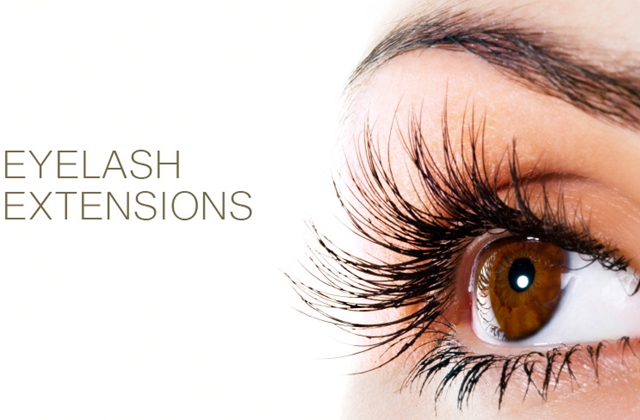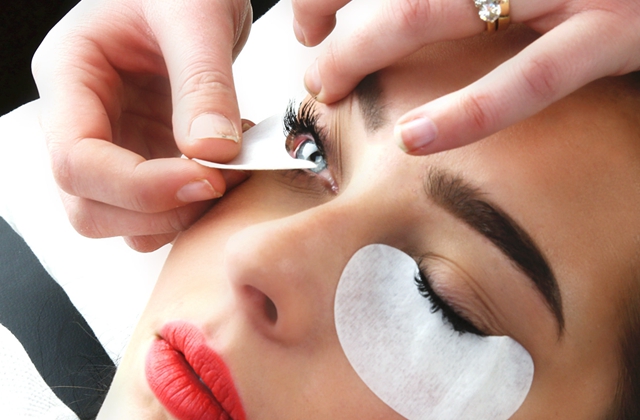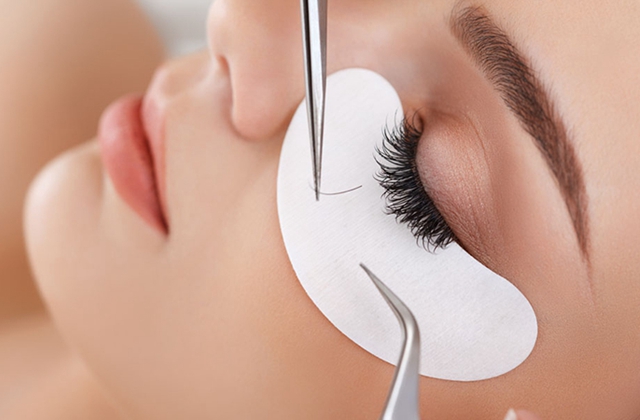
USEFUL TIPS ON EYELASH EXTENSIONS

BE TRUE TO YOUR GLUE
Of course you should be using a high quality adhesive, but also be aware of the related issues that can arise. For instance, clients with especially sensitive eyes may
experience some discomfort from fumes, although that should dissipate as the adhesive dries,. To reduce the risk of potential reactions, use a fan or nano mister to help polymerize the glue during application and work in a well-ventilated area.
Gel odor absorbers and/or carbon pillows, as well as in-studio scent machines, can help keep air fresh. Meanwhile, to protect yourself, be sure to wear a face mask— preferably one with full coverage and a carbon filter.
CLEAN UP YOUR ACT
Thoroughly cleansing your client’s lashes before the service is not only imperative for a strong bond—it’s a must for safety. If there’s makeup, oil or bacteria, the client will be susceptible to infammation, pain or an infection. Everything in your work area should also be regularly cleaned/sanitized, disinfected. For tools, a disinfecting spray, a medical heated ultrasonic cleaning machine and a sterilization dip at 300 degrees are suggested. Supplies, such as lashes, gel pads and tape, should also be kept in containers and stored when not in use; leaving them out can increase the risk for bacteria growth as they are exposed to dust, air, sneezes and coughs, explains Snow. Disposable items, such as pads or tape, must be tossed after one use. Disinfecting hard surfaces (including countertops, work surfaces and even credit card touch screens and door knobs) as well as urging clients to never put their fingers in or around their eyes are highly recommended.
MIND THE GAP
Gel patches help to protect the skin and prevent upper and lower lashes from
sticking together. But improperly placed patches can cause corneal abrasions. They should be placed 1mm to 2mm below the lower lash line, keeping in mind that the sticker will slide slightly closer to the eye when it’s closed. That’s why we suggests applying them with the client’s eyes closed. Or, have the client look straight ahead so the eyelid is in a neutral position. After applying, check to make sure the edges aren’t pushing into the eye.
KEEP THEM SEPARATED
Proper isolation is the most important part of the lash application process—and poor isolation is the No. 1 reason that natural lashes fall out or clients experience pain on the lash line. Separate the lashes so that one natural lash is visible and apply the extension by dropping it onto the natural lash without allowing it or the adhesive to touch the skin. Brush through the lashes frequently with tweezers to make sure they’re separated, and if an extension is adhered to more than one natural lash, remove it. Each extension should be 1mm away from the lash line. When isolating lashes, use curved tweezers. If the lash you’re focusing on won’t isolate, move on. Find the easiest lashes to isolate first and leave the diff cult ones for last.
OFFER INSTRUCTION
Sending home after-care instructions protects your client while building your credibility as a professional. In most cases, instructions include avoiding the use of certain mascaras and steering clear of steam, hot water, spray tanning, oil-based products and running water, especially in the first 24 hours after application, she notes. Post the instructions on your website and retail the proper products, suggests Rattigan. Or send clients home with a full after-care kit and include it in the price of the service.
Search
Categories
Latest News
-
 2012-02-12
2012-02-12 -
 2016-02-22
2016-02-22 -
 2016-06-16
2016-06-16
